Venue Risk Analysis Report: MNG01222, Southern Cross University
VerifiedAdded on 2023/06/04
|20
|3865
|283
Report
AI Summary
This report provides a comprehensive venue risk analysis for Mehfil Indian Restaurant, a business in the hospitality industry. It begins with an executive summary and table of contents, followed by a detailed explanation of the concept of risk, including its various definitions and the importance of risk management for hospitality businesses. The report then delves into a venue risk analysis, outlining a risk assessment structure and a risk analysis form specifically tailored for the restaurant. It identifies various risks, such as those related to event likelihood, time of impact, financial severity, injury severity, and reputational impact. The report also includes an action plan for the identified risks, along with recommendations and a conclusion, supported by references and appendices. The analysis covers the restaurant's information, identified risks, and proposed mitigation strategies. The risk assessment structure includes establishing the context, identifying risks, analyzing risks, evaluating risks, treating risks, monitoring and reviewing, and communication and consulting. The report emphasizes the importance of a risk management process in identifying potential risks, improving brand reputation, and protecting the company's resources.
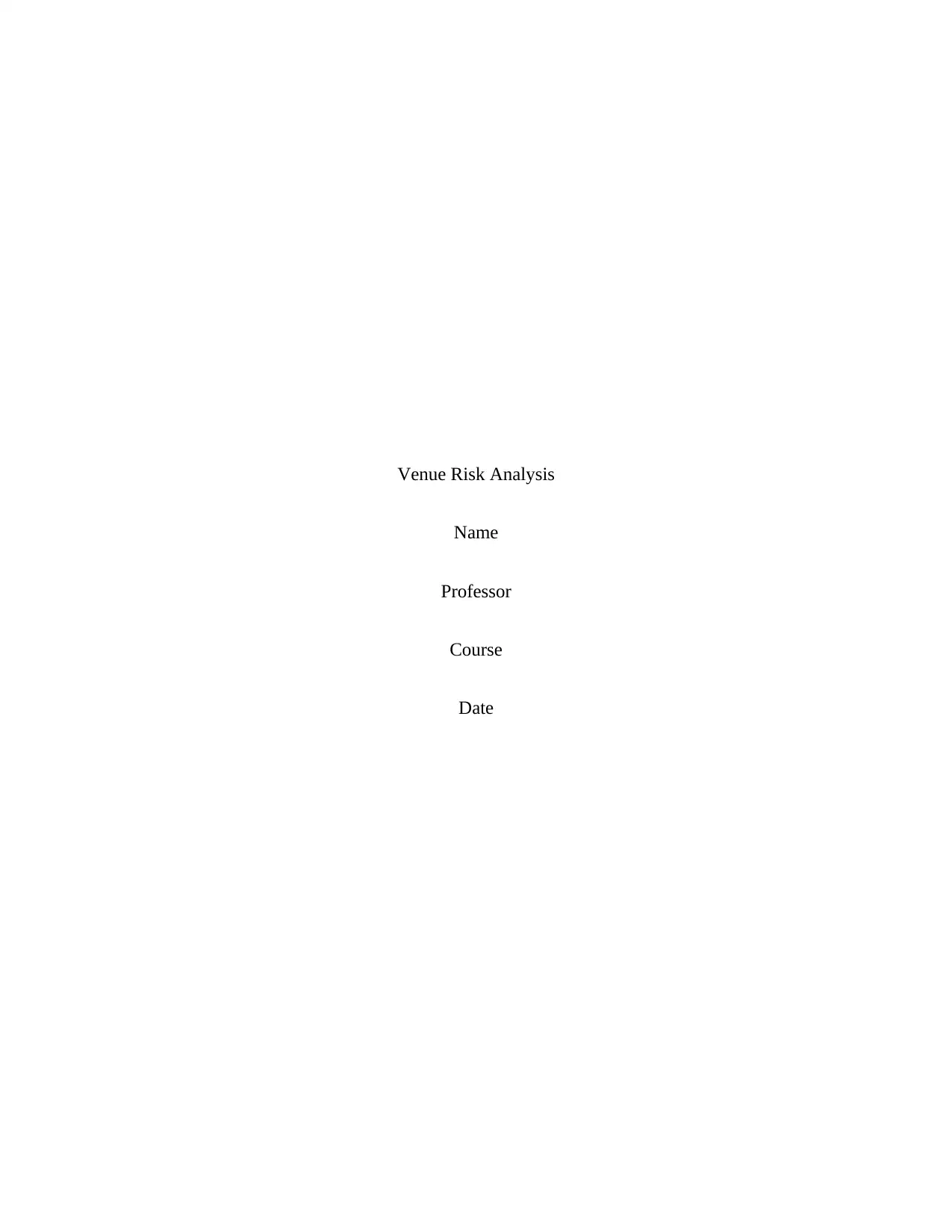
Venue Risk Analysis
Name
Professor
Course
Date
Name
Professor
Course
Date
Paraphrase This Document
Need a fresh take? Get an instant paraphrase of this document with our AI Paraphraser
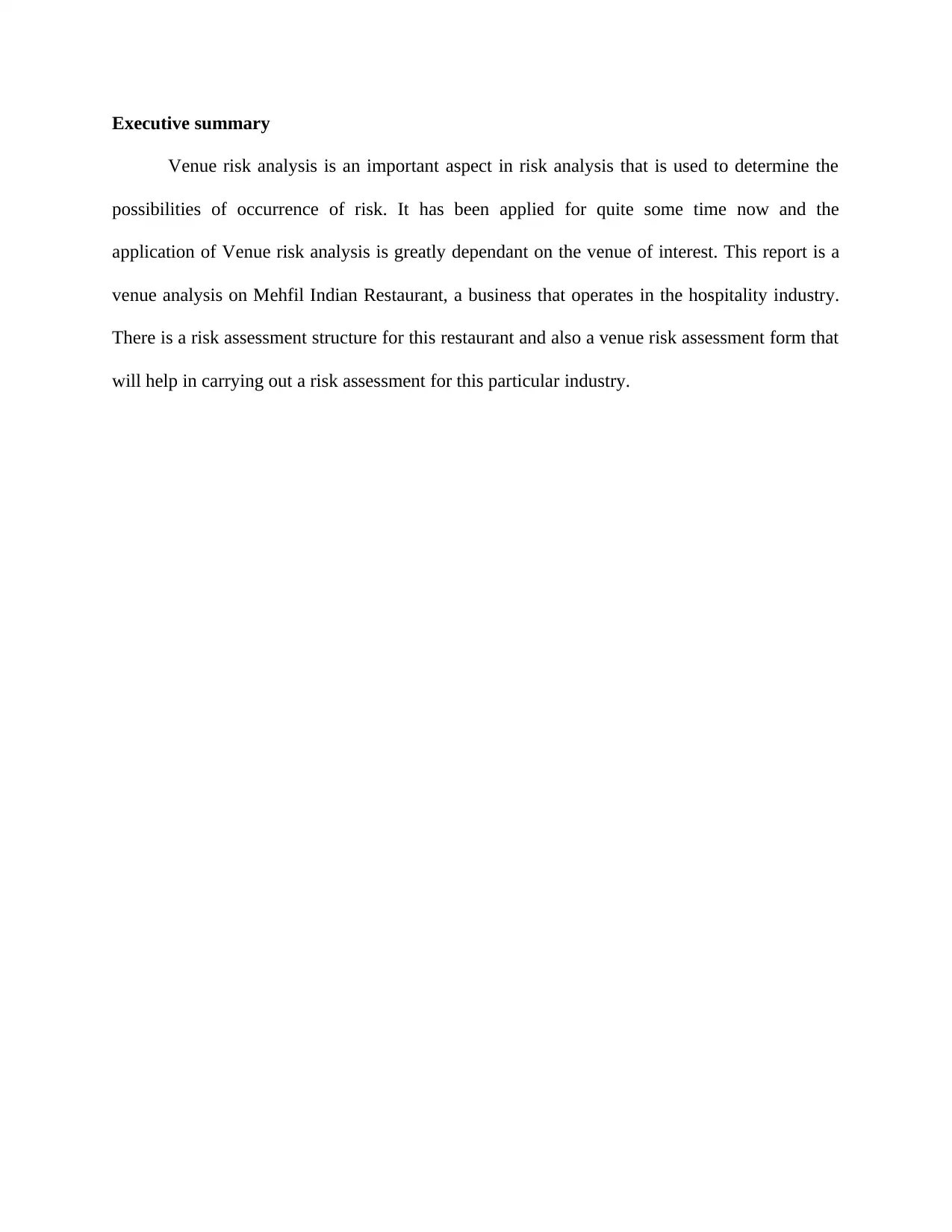
Executive summary
Venue risk analysis is an important aspect in risk analysis that is used to determine the
possibilities of occurrence of risk. It has been applied for quite some time now and the
application of Venue risk analysis is greatly dependant on the venue of interest. This report is a
venue analysis on Mehfil Indian Restaurant, a business that operates in the hospitality industry.
There is a risk assessment structure for this restaurant and also a venue risk assessment form that
will help in carrying out a risk assessment for this particular industry.
Venue risk analysis is an important aspect in risk analysis that is used to determine the
possibilities of occurrence of risk. It has been applied for quite some time now and the
application of Venue risk analysis is greatly dependant on the venue of interest. This report is a
venue analysis on Mehfil Indian Restaurant, a business that operates in the hospitality industry.
There is a risk assessment structure for this restaurant and also a venue risk assessment form that
will help in carrying out a risk assessment for this particular industry.
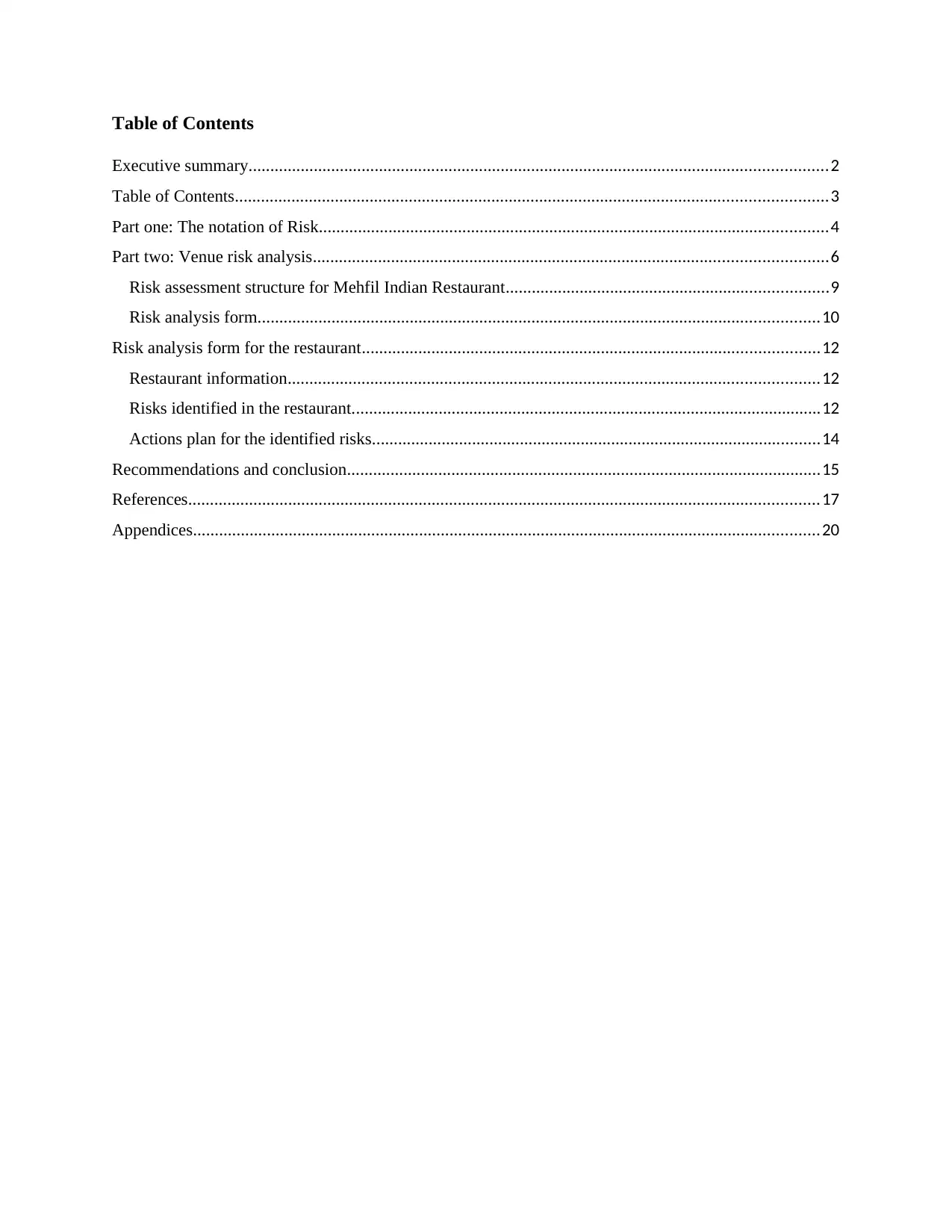
Table of Contents
Executive summary.....................................................................................................................................2
Table of Contents........................................................................................................................................3
Part one: The notation of Risk.....................................................................................................................4
Part two: Venue risk analysis......................................................................................................................6
Risk assessment structure for Mehfil Indian Restaurant..........................................................................9
Risk analysis form.................................................................................................................................10
Risk analysis form for the restaurant.........................................................................................................12
Restaurant information..........................................................................................................................12
Risks identified in the restaurant............................................................................................................12
Actions plan for the identified risks.......................................................................................................14
Recommendations and conclusion.............................................................................................................15
References.................................................................................................................................................17
Appendices................................................................................................................................................20
Executive summary.....................................................................................................................................2
Table of Contents........................................................................................................................................3
Part one: The notation of Risk.....................................................................................................................4
Part two: Venue risk analysis......................................................................................................................6
Risk assessment structure for Mehfil Indian Restaurant..........................................................................9
Risk analysis form.................................................................................................................................10
Risk analysis form for the restaurant.........................................................................................................12
Restaurant information..........................................................................................................................12
Risks identified in the restaurant............................................................................................................12
Actions plan for the identified risks.......................................................................................................14
Recommendations and conclusion.............................................................................................................15
References.................................................................................................................................................17
Appendices................................................................................................................................................20
⊘ This is a preview!⊘
Do you want full access?
Subscribe today to unlock all pages.

Trusted by 1+ million students worldwide
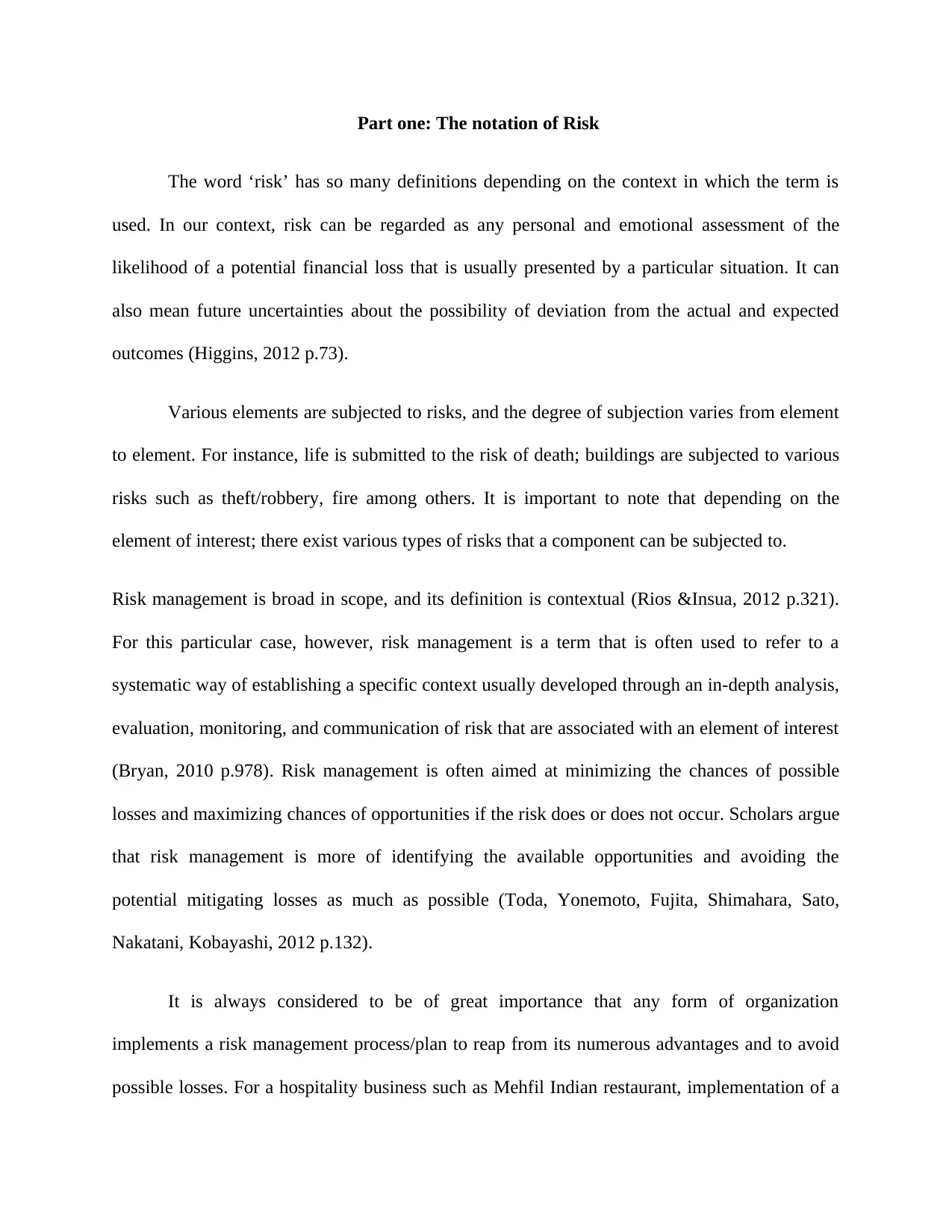
Part one: The notation of Risk
The word ‘risk’ has so many definitions depending on the context in which the term is
used. In our context, risk can be regarded as any personal and emotional assessment of the
likelihood of a potential financial loss that is usually presented by a particular situation. It can
also mean future uncertainties about the possibility of deviation from the actual and expected
outcomes (Higgins, 2012 p.73).
Various elements are subjected to risks, and the degree of subjection varies from element
to element. For instance, life is submitted to the risk of death; buildings are subjected to various
risks such as theft/robbery, fire among others. It is important to note that depending on the
element of interest; there exist various types of risks that a component can be subjected to.
Risk management is broad in scope, and its definition is contextual (Rios &Insua, 2012 p.321).
For this particular case, however, risk management is a term that is often used to refer to a
systematic way of establishing a specific context usually developed through an in-depth analysis,
evaluation, monitoring, and communication of risk that are associated with an element of interest
(Bryan, 2010 p.978). Risk management is often aimed at minimizing the chances of possible
losses and maximizing chances of opportunities if the risk does or does not occur. Scholars argue
that risk management is more of identifying the available opportunities and avoiding the
potential mitigating losses as much as possible (Toda, Yonemoto, Fujita, Shimahara, Sato,
Nakatani, Kobayashi, 2012 p.132).
It is always considered to be of great importance that any form of organization
implements a risk management process/plan to reap from its numerous advantages and to avoid
possible losses. For a hospitality business such as Mehfil Indian restaurant, implementation of a
The word ‘risk’ has so many definitions depending on the context in which the term is
used. In our context, risk can be regarded as any personal and emotional assessment of the
likelihood of a potential financial loss that is usually presented by a particular situation. It can
also mean future uncertainties about the possibility of deviation from the actual and expected
outcomes (Higgins, 2012 p.73).
Various elements are subjected to risks, and the degree of subjection varies from element
to element. For instance, life is submitted to the risk of death; buildings are subjected to various
risks such as theft/robbery, fire among others. It is important to note that depending on the
element of interest; there exist various types of risks that a component can be subjected to.
Risk management is broad in scope, and its definition is contextual (Rios &Insua, 2012 p.321).
For this particular case, however, risk management is a term that is often used to refer to a
systematic way of establishing a specific context usually developed through an in-depth analysis,
evaluation, monitoring, and communication of risk that are associated with an element of interest
(Bryan, 2010 p.978). Risk management is often aimed at minimizing the chances of possible
losses and maximizing chances of opportunities if the risk does or does not occur. Scholars argue
that risk management is more of identifying the available opportunities and avoiding the
potential mitigating losses as much as possible (Toda, Yonemoto, Fujita, Shimahara, Sato,
Nakatani, Kobayashi, 2012 p.132).
It is always considered to be of great importance that any form of organization
implements a risk management process/plan to reap from its numerous advantages and to avoid
possible losses. For a hospitality business such as Mehfil Indian restaurant, implementation of a
Paraphrase This Document
Need a fresh take? Get an instant paraphrase of this document with our AI Paraphraser
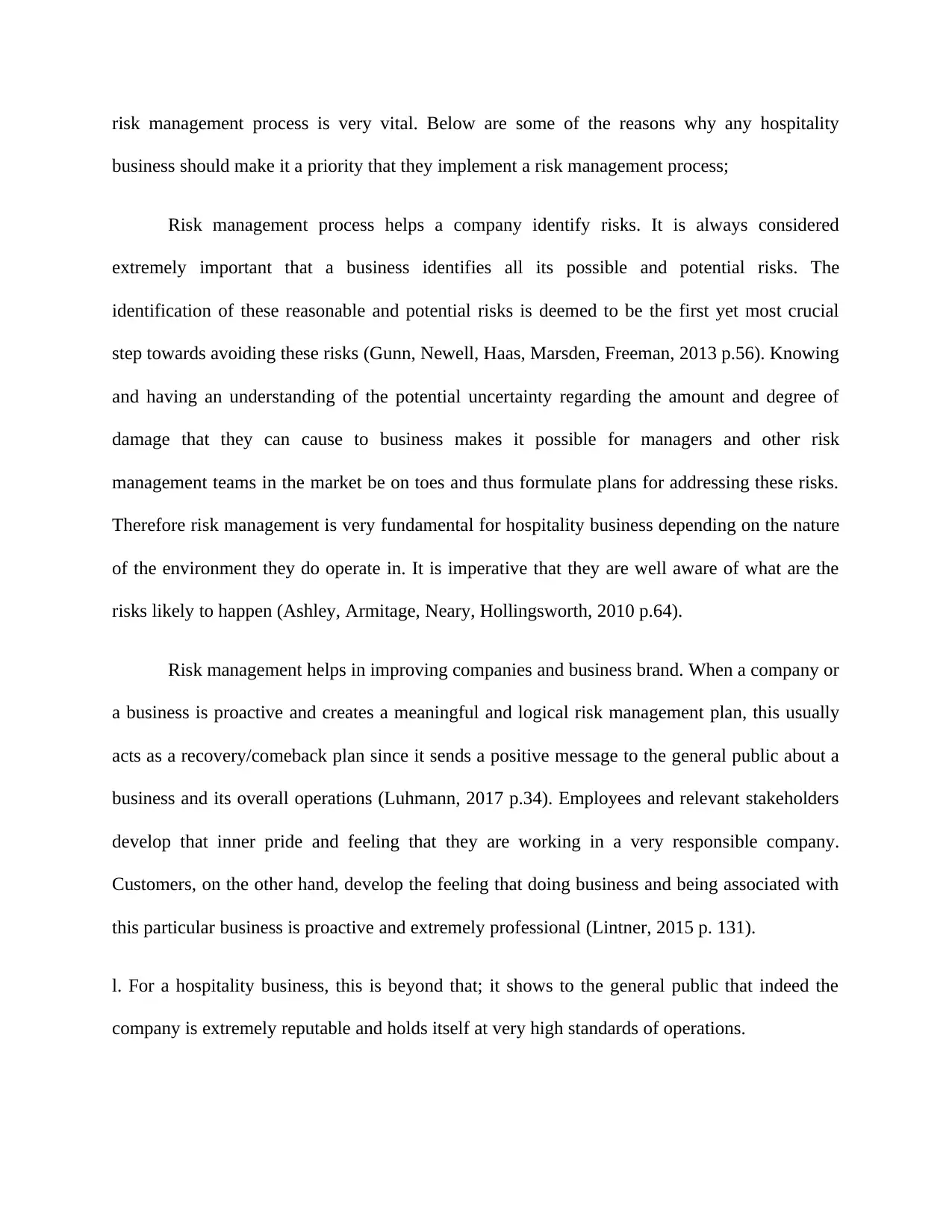
risk management process is very vital. Below are some of the reasons why any hospitality
business should make it a priority that they implement a risk management process;
Risk management process helps a company identify risks. It is always considered
extremely important that a business identifies all its possible and potential risks. The
identification of these reasonable and potential risks is deemed to be the first yet most crucial
step towards avoiding these risks (Gunn, Newell, Haas, Marsden, Freeman, 2013 p.56). Knowing
and having an understanding of the potential uncertainty regarding the amount and degree of
damage that they can cause to business makes it possible for managers and other risk
management teams in the market be on toes and thus formulate plans for addressing these risks.
Therefore risk management is very fundamental for hospitality business depending on the nature
of the environment they do operate in. It is imperative that they are well aware of what are the
risks likely to happen (Ashley, Armitage, Neary, Hollingsworth, 2010 p.64).
Risk management helps in improving companies and business brand. When a company or
a business is proactive and creates a meaningful and logical risk management plan, this usually
acts as a recovery/comeback plan since it sends a positive message to the general public about a
business and its overall operations (Luhmann, 2017 p.34). Employees and relevant stakeholders
develop that inner pride and feeling that they are working in a very responsible company.
Customers, on the other hand, develop the feeling that doing business and being associated with
this particular business is proactive and extremely professional (Lintner, 2015 p. 131).
l. For a hospitality business, this is beyond that; it shows to the general public that indeed the
company is extremely reputable and holds itself at very high standards of operations.
business should make it a priority that they implement a risk management process;
Risk management process helps a company identify risks. It is always considered
extremely important that a business identifies all its possible and potential risks. The
identification of these reasonable and potential risks is deemed to be the first yet most crucial
step towards avoiding these risks (Gunn, Newell, Haas, Marsden, Freeman, 2013 p.56). Knowing
and having an understanding of the potential uncertainty regarding the amount and degree of
damage that they can cause to business makes it possible for managers and other risk
management teams in the market be on toes and thus formulate plans for addressing these risks.
Therefore risk management is very fundamental for hospitality business depending on the nature
of the environment they do operate in. It is imperative that they are well aware of what are the
risks likely to happen (Ashley, Armitage, Neary, Hollingsworth, 2010 p.64).
Risk management helps in improving companies and business brand. When a company or
a business is proactive and creates a meaningful and logical risk management plan, this usually
acts as a recovery/comeback plan since it sends a positive message to the general public about a
business and its overall operations (Luhmann, 2017 p.34). Employees and relevant stakeholders
develop that inner pride and feeling that they are working in a very responsible company.
Customers, on the other hand, develop the feeling that doing business and being associated with
this particular business is proactive and extremely professional (Lintner, 2015 p. 131).
l. For a hospitality business, this is beyond that; it shows to the general public that indeed the
company is extremely reputable and holds itself at very high standards of operations.
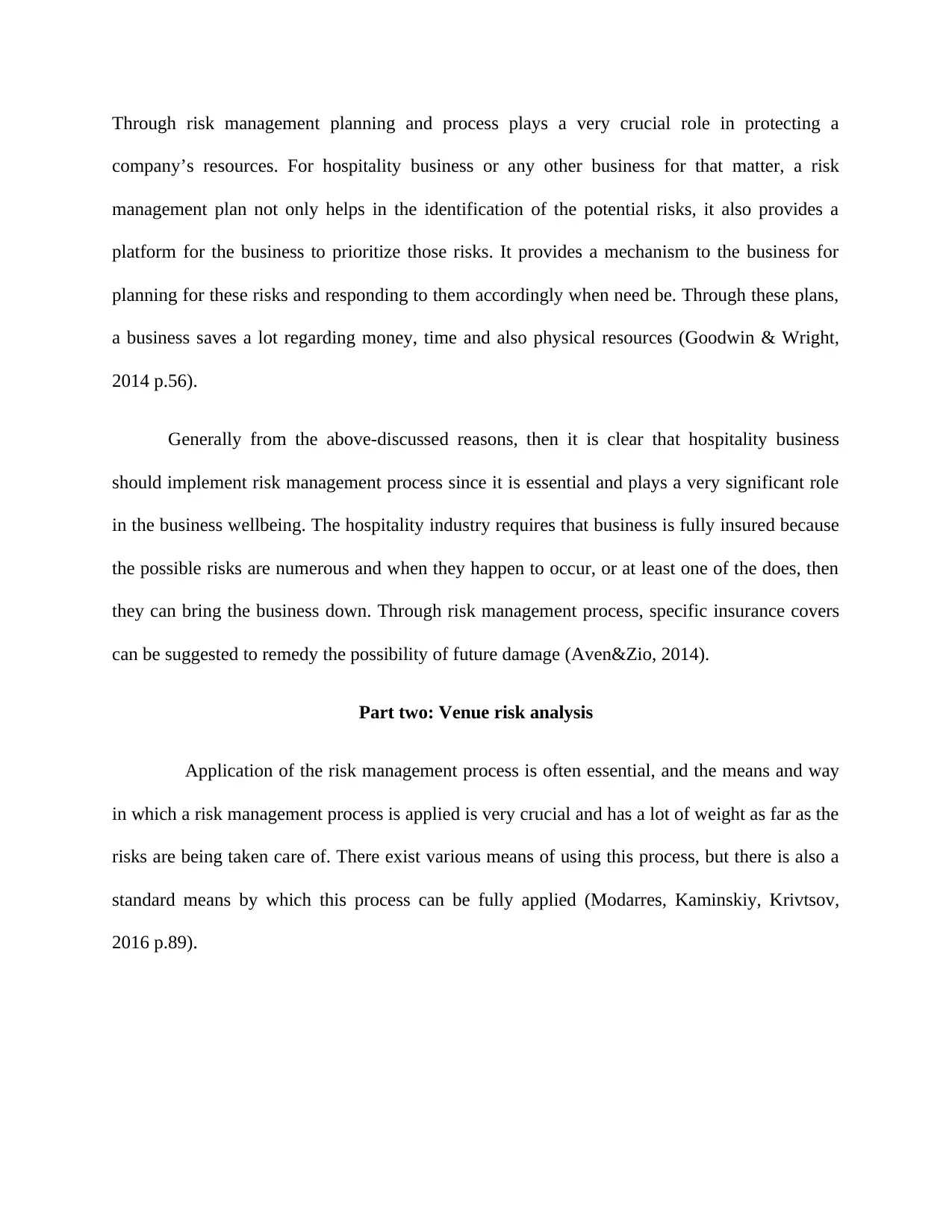
Through risk management planning and process plays a very crucial role in protecting a
company’s resources. For hospitality business or any other business for that matter, a risk
management plan not only helps in the identification of the potential risks, it also provides a
platform for the business to prioritize those risks. It provides a mechanism to the business for
planning for these risks and responding to them accordingly when need be. Through these plans,
a business saves a lot regarding money, time and also physical resources (Goodwin & Wright,
2014 p.56).
Generally from the above-discussed reasons, then it is clear that hospitality business
should implement risk management process since it is essential and plays a very significant role
in the business wellbeing. The hospitality industry requires that business is fully insured because
the possible risks are numerous and when they happen to occur, or at least one of the does, then
they can bring the business down. Through risk management process, specific insurance covers
can be suggested to remedy the possibility of future damage (Aven&Zio, 2014).
Part two: Venue risk analysis
Application of the risk management process is often essential, and the means and way
in which a risk management process is applied is very crucial and has a lot of weight as far as the
risks are being taken care of. There exist various means of using this process, but there is also a
standard means by which this process can be fully applied (Modarres, Kaminskiy, Krivtsov,
2016 p.89).
company’s resources. For hospitality business or any other business for that matter, a risk
management plan not only helps in the identification of the potential risks, it also provides a
platform for the business to prioritize those risks. It provides a mechanism to the business for
planning for these risks and responding to them accordingly when need be. Through these plans,
a business saves a lot regarding money, time and also physical resources (Goodwin & Wright,
2014 p.56).
Generally from the above-discussed reasons, then it is clear that hospitality business
should implement risk management process since it is essential and plays a very significant role
in the business wellbeing. The hospitality industry requires that business is fully insured because
the possible risks are numerous and when they happen to occur, or at least one of the does, then
they can bring the business down. Through risk management process, specific insurance covers
can be suggested to remedy the possibility of future damage (Aven&Zio, 2014).
Part two: Venue risk analysis
Application of the risk management process is often essential, and the means and way
in which a risk management process is applied is very crucial and has a lot of weight as far as the
risks are being taken care of. There exist various means of using this process, but there is also a
standard means by which this process can be fully applied (Modarres, Kaminskiy, Krivtsov,
2016 p.89).
⊘ This is a preview!⊘
Do you want full access?
Subscribe today to unlock all pages.

Trusted by 1+ million students worldwide
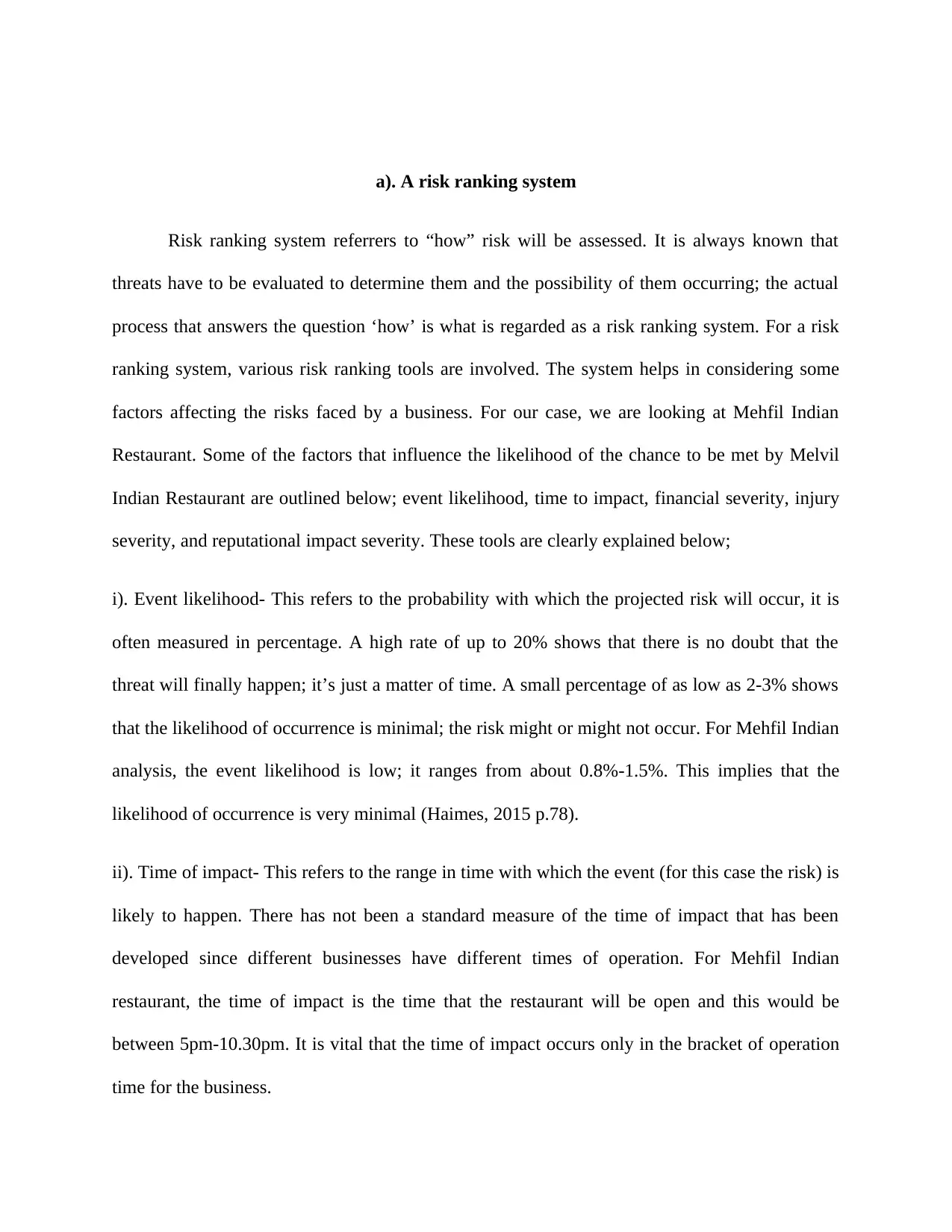
a). A risk ranking system
Risk ranking system referrers to “how” risk will be assessed. It is always known that
threats have to be evaluated to determine them and the possibility of them occurring; the actual
process that answers the question ‘how’ is what is regarded as a risk ranking system. For a risk
ranking system, various risk ranking tools are involved. The system helps in considering some
factors affecting the risks faced by a business. For our case, we are looking at Mehfil Indian
Restaurant. Some of the factors that influence the likelihood of the chance to be met by Melvil
Indian Restaurant are outlined below; event likelihood, time to impact, financial severity, injury
severity, and reputational impact severity. These tools are clearly explained below;
i). Event likelihood- This refers to the probability with which the projected risk will occur, it is
often measured in percentage. A high rate of up to 20% shows that there is no doubt that the
threat will finally happen; it’s just a matter of time. A small percentage of as low as 2-3% shows
that the likelihood of occurrence is minimal; the risk might or might not occur. For Mehfil Indian
analysis, the event likelihood is low; it ranges from about 0.8%-1.5%. This implies that the
likelihood of occurrence is very minimal (Haimes, 2015 p.78).
ii). Time of impact- This refers to the range in time with which the event (for this case the risk) is
likely to happen. There has not been a standard measure of the time of impact that has been
developed since different businesses have different times of operation. For Mehfil Indian
restaurant, the time of impact is the time that the restaurant will be open and this would be
between 5pm-10.30pm. It is vital that the time of impact occurs only in the bracket of operation
time for the business.
Risk ranking system referrers to “how” risk will be assessed. It is always known that
threats have to be evaluated to determine them and the possibility of them occurring; the actual
process that answers the question ‘how’ is what is regarded as a risk ranking system. For a risk
ranking system, various risk ranking tools are involved. The system helps in considering some
factors affecting the risks faced by a business. For our case, we are looking at Mehfil Indian
Restaurant. Some of the factors that influence the likelihood of the chance to be met by Melvil
Indian Restaurant are outlined below; event likelihood, time to impact, financial severity, injury
severity, and reputational impact severity. These tools are clearly explained below;
i). Event likelihood- This refers to the probability with which the projected risk will occur, it is
often measured in percentage. A high rate of up to 20% shows that there is no doubt that the
threat will finally happen; it’s just a matter of time. A small percentage of as low as 2-3% shows
that the likelihood of occurrence is minimal; the risk might or might not occur. For Mehfil Indian
analysis, the event likelihood is low; it ranges from about 0.8%-1.5%. This implies that the
likelihood of occurrence is very minimal (Haimes, 2015 p.78).
ii). Time of impact- This refers to the range in time with which the event (for this case the risk) is
likely to happen. There has not been a standard measure of the time of impact that has been
developed since different businesses have different times of operation. For Mehfil Indian
restaurant, the time of impact is the time that the restaurant will be open and this would be
between 5pm-10.30pm. It is vital that the time of impact occurs only in the bracket of operation
time for the business.
Paraphrase This Document
Need a fresh take? Get an instant paraphrase of this document with our AI Paraphraser
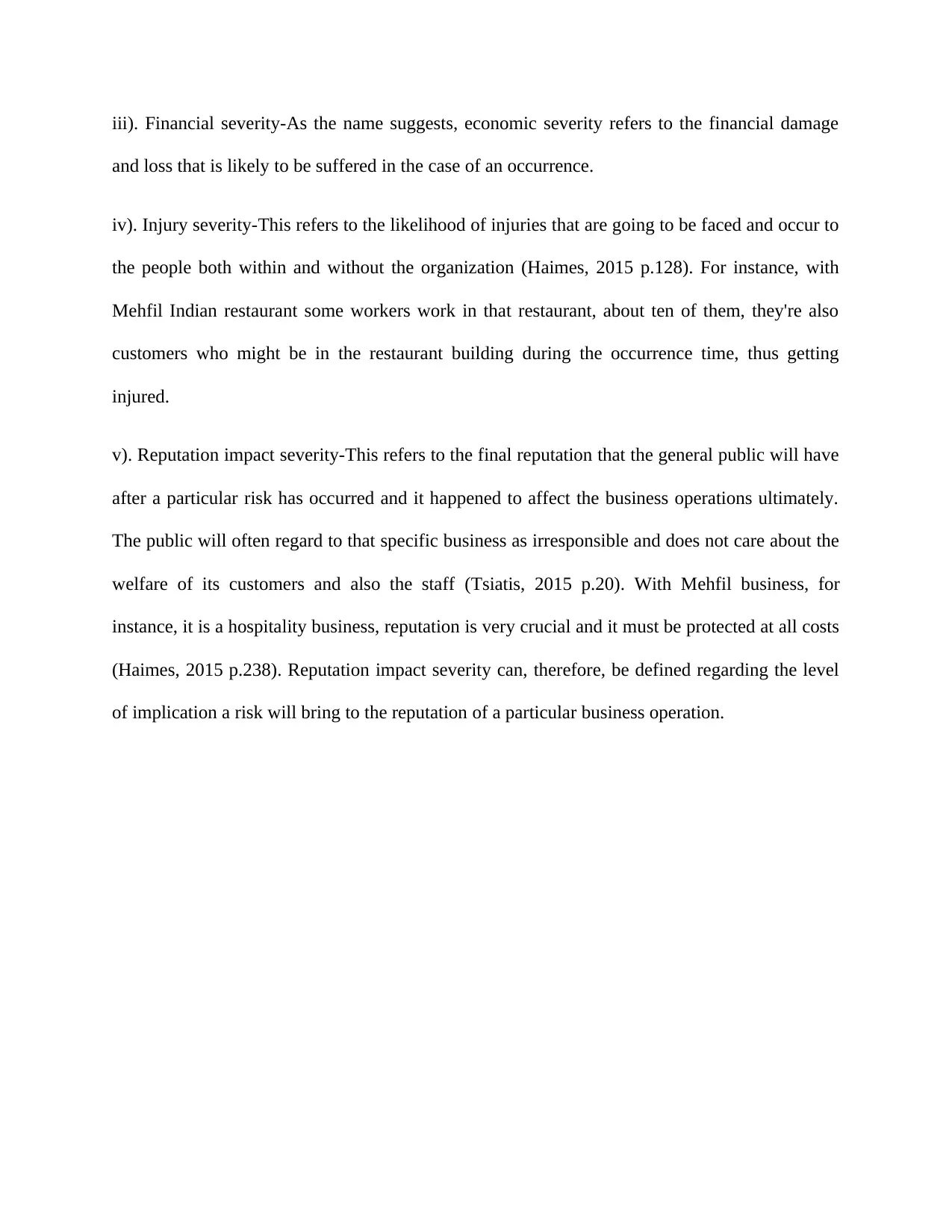
iii). Financial severity-As the name suggests, economic severity refers to the financial damage
and loss that is likely to be suffered in the case of an occurrence.
iv). Injury severity-This refers to the likelihood of injuries that are going to be faced and occur to
the people both within and without the organization (Haimes, 2015 p.128). For instance, with
Mehfil Indian restaurant some workers work in that restaurant, about ten of them, they're also
customers who might be in the restaurant building during the occurrence time, thus getting
injured.
v). Reputation impact severity-This refers to the final reputation that the general public will have
after a particular risk has occurred and it happened to affect the business operations ultimately.
The public will often regard to that specific business as irresponsible and does not care about the
welfare of its customers and also the staff (Tsiatis, 2015 p.20). With Mehfil business, for
instance, it is a hospitality business, reputation is very crucial and it must be protected at all costs
(Haimes, 2015 p.238). Reputation impact severity can, therefore, be defined regarding the level
of implication a risk will bring to the reputation of a particular business operation.
and loss that is likely to be suffered in the case of an occurrence.
iv). Injury severity-This refers to the likelihood of injuries that are going to be faced and occur to
the people both within and without the organization (Haimes, 2015 p.128). For instance, with
Mehfil Indian restaurant some workers work in that restaurant, about ten of them, they're also
customers who might be in the restaurant building during the occurrence time, thus getting
injured.
v). Reputation impact severity-This refers to the final reputation that the general public will have
after a particular risk has occurred and it happened to affect the business operations ultimately.
The public will often regard to that specific business as irresponsible and does not care about the
welfare of its customers and also the staff (Tsiatis, 2015 p.20). With Mehfil business, for
instance, it is a hospitality business, reputation is very crucial and it must be protected at all costs
(Haimes, 2015 p.238). Reputation impact severity can, therefore, be defined regarding the level
of implication a risk will bring to the reputation of a particular business operation.
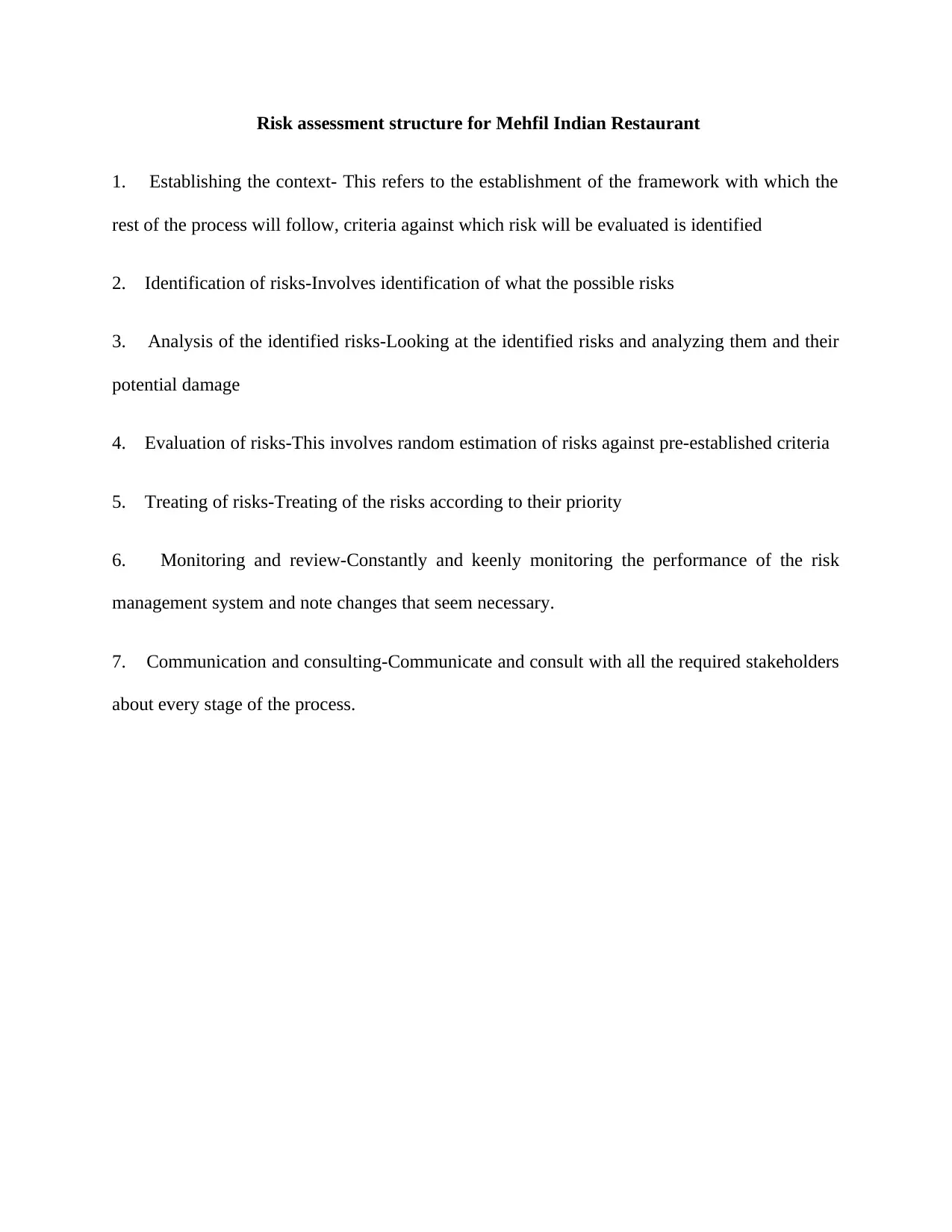
Risk assessment structure for Mehfil Indian Restaurant
1. Establishing the context- This refers to the establishment of the framework with which the
rest of the process will follow, criteria against which risk will be evaluated is identified
2. Identification of risks-Involves identification of what the possible risks
3. Analysis of the identified risks-Looking at the identified risks and analyzing them and their
potential damage
4. Evaluation of risks-This involves random estimation of risks against pre-established criteria
5. Treating of risks-Treating of the risks according to their priority
6. Monitoring and review-Constantly and keenly monitoring the performance of the risk
management system and note changes that seem necessary.
7. Communication and consulting-Communicate and consult with all the required stakeholders
about every stage of the process.
1. Establishing the context- This refers to the establishment of the framework with which the
rest of the process will follow, criteria against which risk will be evaluated is identified
2. Identification of risks-Involves identification of what the possible risks
3. Analysis of the identified risks-Looking at the identified risks and analyzing them and their
potential damage
4. Evaluation of risks-This involves random estimation of risks against pre-established criteria
5. Treating of risks-Treating of the risks according to their priority
6. Monitoring and review-Constantly and keenly monitoring the performance of the risk
management system and note changes that seem necessary.
7. Communication and consulting-Communicate and consult with all the required stakeholders
about every stage of the process.
⊘ This is a preview!⊘
Do you want full access?
Subscribe today to unlock all pages.

Trusted by 1+ million students worldwide
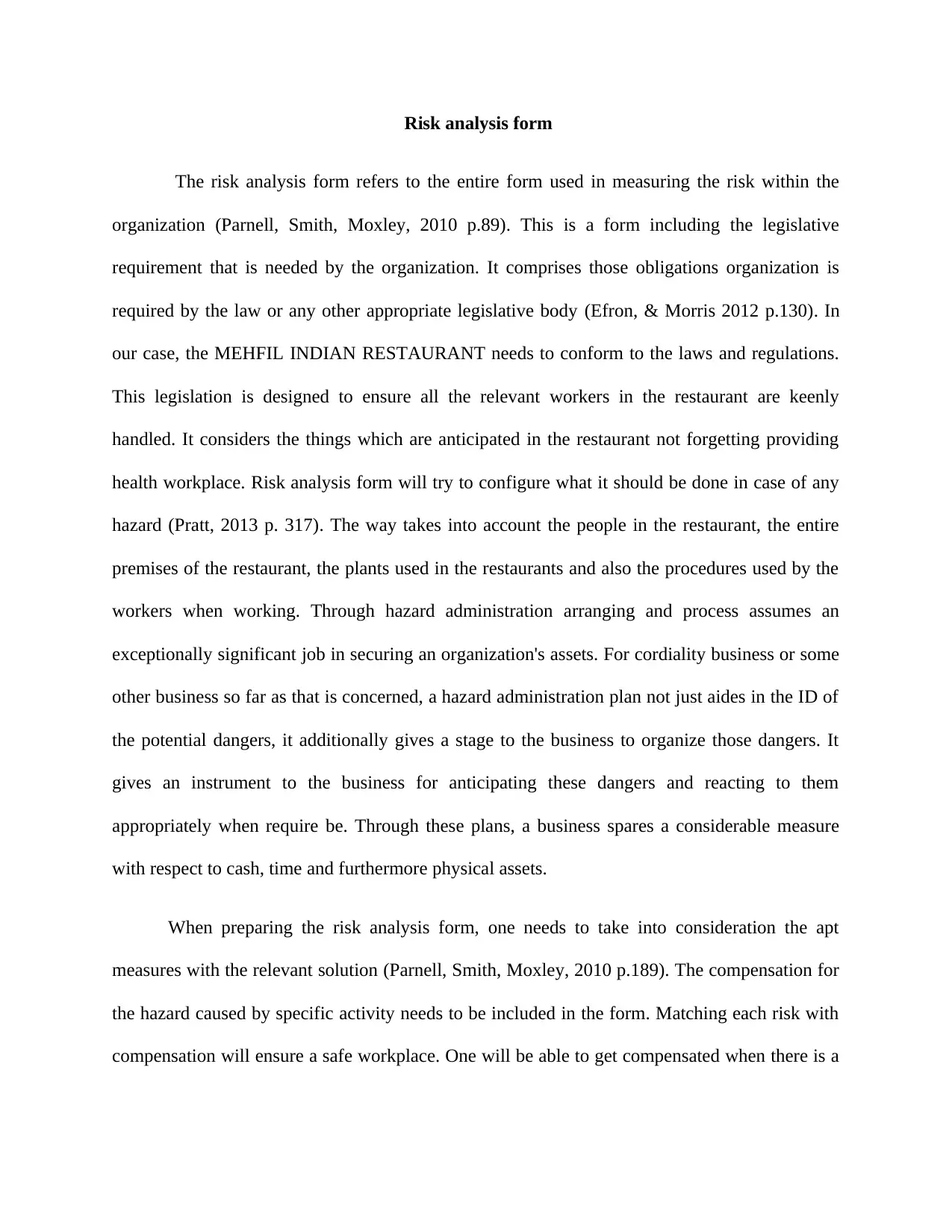
Risk analysis form
The risk analysis form refers to the entire form used in measuring the risk within the
organization (Parnell, Smith, Moxley, 2010 p.89). This is a form including the legislative
requirement that is needed by the organization. It comprises those obligations organization is
required by the law or any other appropriate legislative body (Efron, & Morris 2012 p.130). In
our case, the MEHFIL INDIAN RESTAURANT needs to conform to the laws and regulations.
This legislation is designed to ensure all the relevant workers in the restaurant are keenly
handled. It considers the things which are anticipated in the restaurant not forgetting providing
health workplace. Risk analysis form will try to configure what it should be done in case of any
hazard (Pratt, 2013 p. 317). The way takes into account the people in the restaurant, the entire
premises of the restaurant, the plants used in the restaurants and also the procedures used by the
workers when working. Through hazard administration arranging and process assumes an
exceptionally significant job in securing an organization's assets. For cordiality business or some
other business so far as that is concerned, a hazard administration plan not just aides in the ID of
the potential dangers, it additionally gives a stage to the business to organize those dangers. It
gives an instrument to the business for anticipating these dangers and reacting to them
appropriately when require be. Through these plans, a business spares a considerable measure
with respect to cash, time and furthermore physical assets.
When preparing the risk analysis form, one needs to take into consideration the apt
measures with the relevant solution (Parnell, Smith, Moxley, 2010 p.189). The compensation for
the hazard caused by specific activity needs to be included in the form. Matching each risk with
compensation will ensure a safe workplace. One will be able to get compensated when there is a
The risk analysis form refers to the entire form used in measuring the risk within the
organization (Parnell, Smith, Moxley, 2010 p.89). This is a form including the legislative
requirement that is needed by the organization. It comprises those obligations organization is
required by the law or any other appropriate legislative body (Efron, & Morris 2012 p.130). In
our case, the MEHFIL INDIAN RESTAURANT needs to conform to the laws and regulations.
This legislation is designed to ensure all the relevant workers in the restaurant are keenly
handled. It considers the things which are anticipated in the restaurant not forgetting providing
health workplace. Risk analysis form will try to configure what it should be done in case of any
hazard (Pratt, 2013 p. 317). The way takes into account the people in the restaurant, the entire
premises of the restaurant, the plants used in the restaurants and also the procedures used by the
workers when working. Through hazard administration arranging and process assumes an
exceptionally significant job in securing an organization's assets. For cordiality business or some
other business so far as that is concerned, a hazard administration plan not just aides in the ID of
the potential dangers, it additionally gives a stage to the business to organize those dangers. It
gives an instrument to the business for anticipating these dangers and reacting to them
appropriately when require be. Through these plans, a business spares a considerable measure
with respect to cash, time and furthermore physical assets.
When preparing the risk analysis form, one needs to take into consideration the apt
measures with the relevant solution (Parnell, Smith, Moxley, 2010 p.189). The compensation for
the hazard caused by specific activity needs to be included in the form. Matching each risk with
compensation will ensure a safe workplace. One will be able to get compensated when there is a
Paraphrase This Document
Need a fresh take? Get an instant paraphrase of this document with our AI Paraphraser
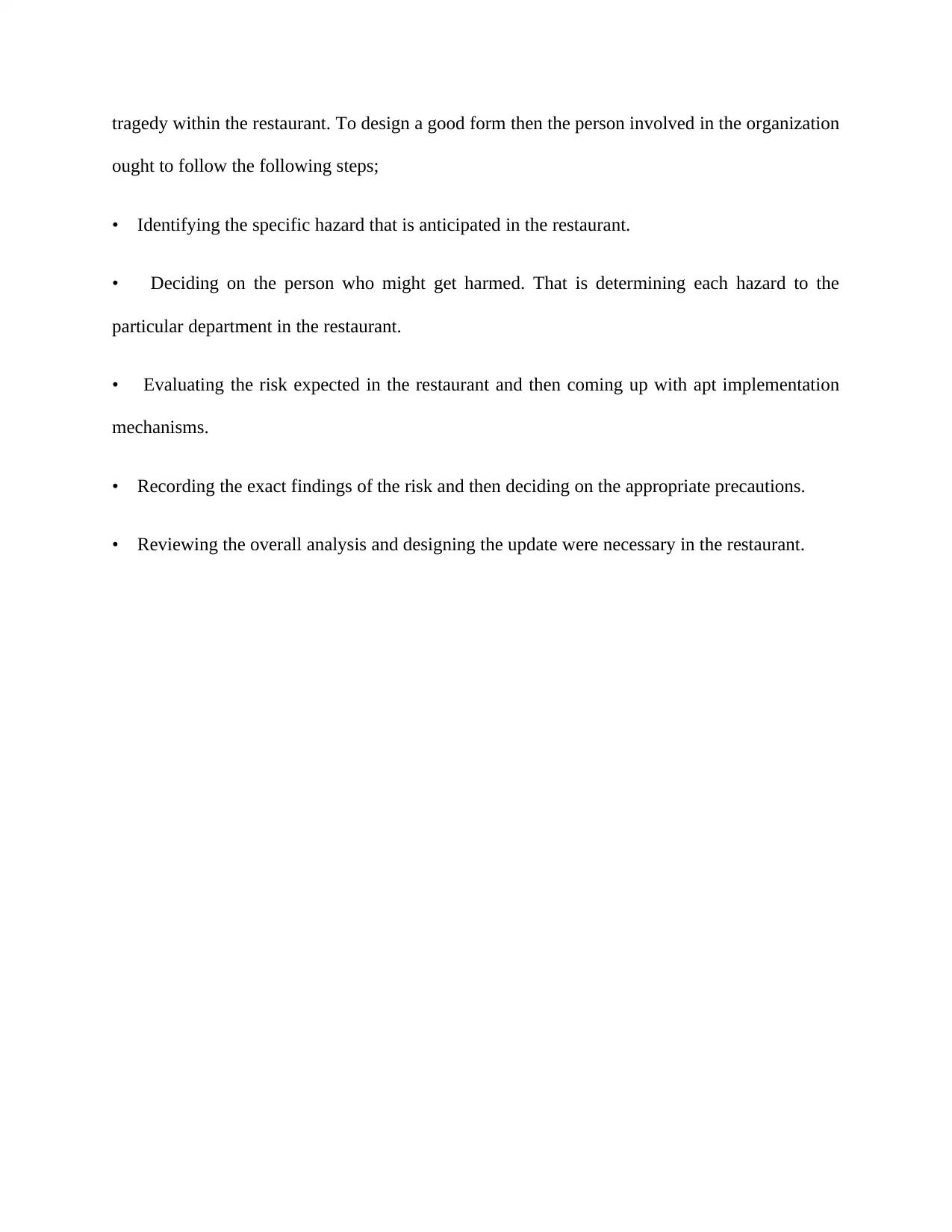
tragedy within the restaurant. To design a good form then the person involved in the organization
ought to follow the following steps;
• Identifying the specific hazard that is anticipated in the restaurant.
• Deciding on the person who might get harmed. That is determining each hazard to the
particular department in the restaurant.
• Evaluating the risk expected in the restaurant and then coming up with apt implementation
mechanisms.
• Recording the exact findings of the risk and then deciding on the appropriate precautions.
• Reviewing the overall analysis and designing the update were necessary in the restaurant.
ought to follow the following steps;
• Identifying the specific hazard that is anticipated in the restaurant.
• Deciding on the person who might get harmed. That is determining each hazard to the
particular department in the restaurant.
• Evaluating the risk expected in the restaurant and then coming up with apt implementation
mechanisms.
• Recording the exact findings of the risk and then deciding on the appropriate precautions.
• Reviewing the overall analysis and designing the update were necessary in the restaurant.
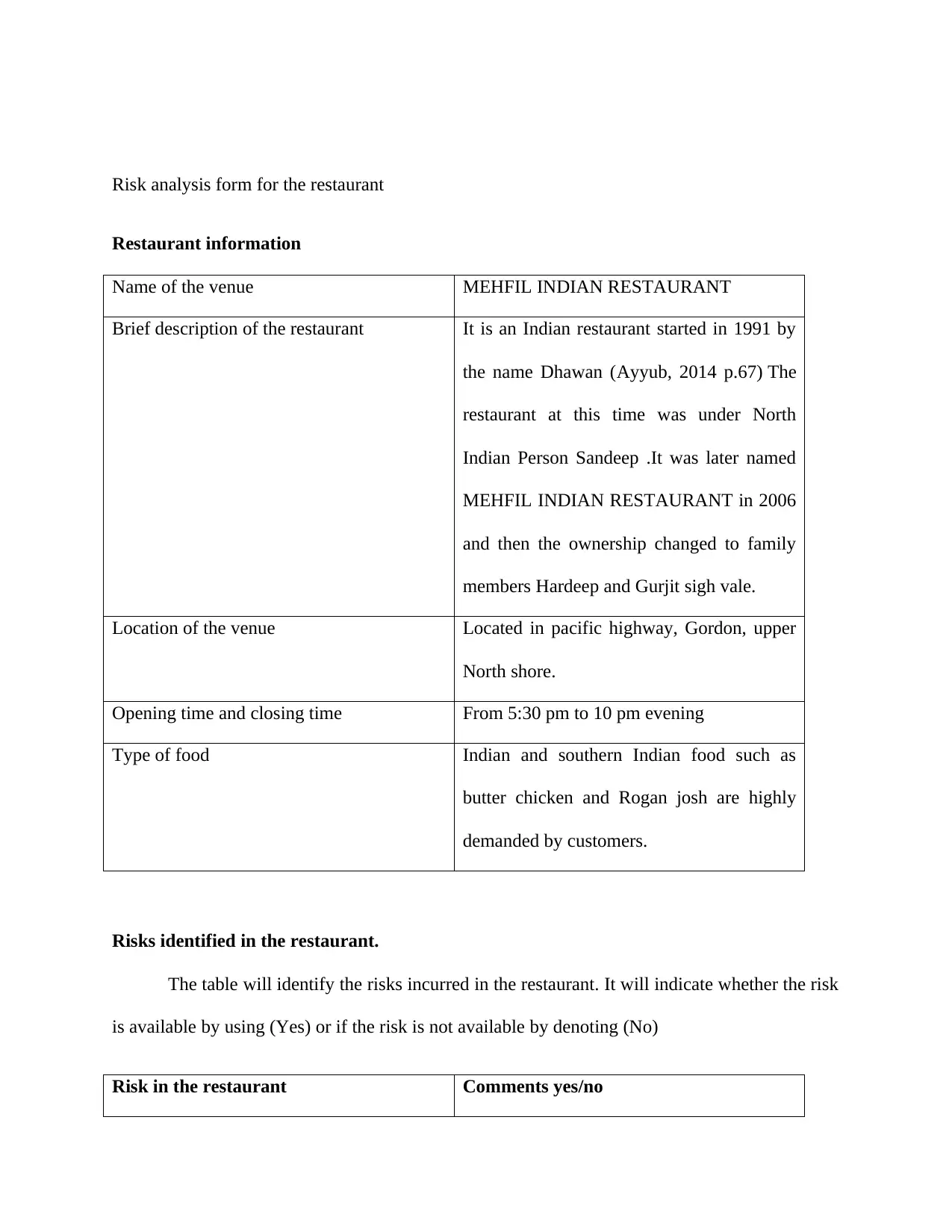
Risk analysis form for the restaurant
Restaurant information
Name of the venue MEHFIL INDIAN RESTAURANT
Brief description of the restaurant It is an Indian restaurant started in 1991 by
the name Dhawan (Ayyub, 2014 p.67) The
restaurant at this time was under North
Indian Person Sandeep .It was later named
MEHFIL INDIAN RESTAURANT in 2006
and then the ownership changed to family
members Hardeep and Gurjit sigh vale.
Location of the venue Located in pacific highway, Gordon, upper
North shore.
Opening time and closing time From 5:30 pm to 10 pm evening
Type of food Indian and southern Indian food such as
butter chicken and Rogan josh are highly
demanded by customers.
Risks identified in the restaurant.
The table will identify the risks incurred in the restaurant. It will indicate whether the risk
is available by using (Yes) or if the risk is not available by denoting (No)
Risk in the restaurant Comments yes/no
Restaurant information
Name of the venue MEHFIL INDIAN RESTAURANT
Brief description of the restaurant It is an Indian restaurant started in 1991 by
the name Dhawan (Ayyub, 2014 p.67) The
restaurant at this time was under North
Indian Person Sandeep .It was later named
MEHFIL INDIAN RESTAURANT in 2006
and then the ownership changed to family
members Hardeep and Gurjit sigh vale.
Location of the venue Located in pacific highway, Gordon, upper
North shore.
Opening time and closing time From 5:30 pm to 10 pm evening
Type of food Indian and southern Indian food such as
butter chicken and Rogan josh are highly
demanded by customers.
Risks identified in the restaurant.
The table will identify the risks incurred in the restaurant. It will indicate whether the risk
is available by using (Yes) or if the risk is not available by denoting (No)
Risk in the restaurant Comments yes/no
⊘ This is a preview!⊘
Do you want full access?
Subscribe today to unlock all pages.

Trusted by 1+ million students worldwide
1 out of 20
Related Documents
Your All-in-One AI-Powered Toolkit for Academic Success.
+13062052269
info@desklib.com
Available 24*7 on WhatsApp / Email
![[object Object]](/_next/static/media/star-bottom.7253800d.svg)
Unlock your academic potential
Copyright © 2020–2025 A2Z Services. All Rights Reserved. Developed and managed by ZUCOL.





